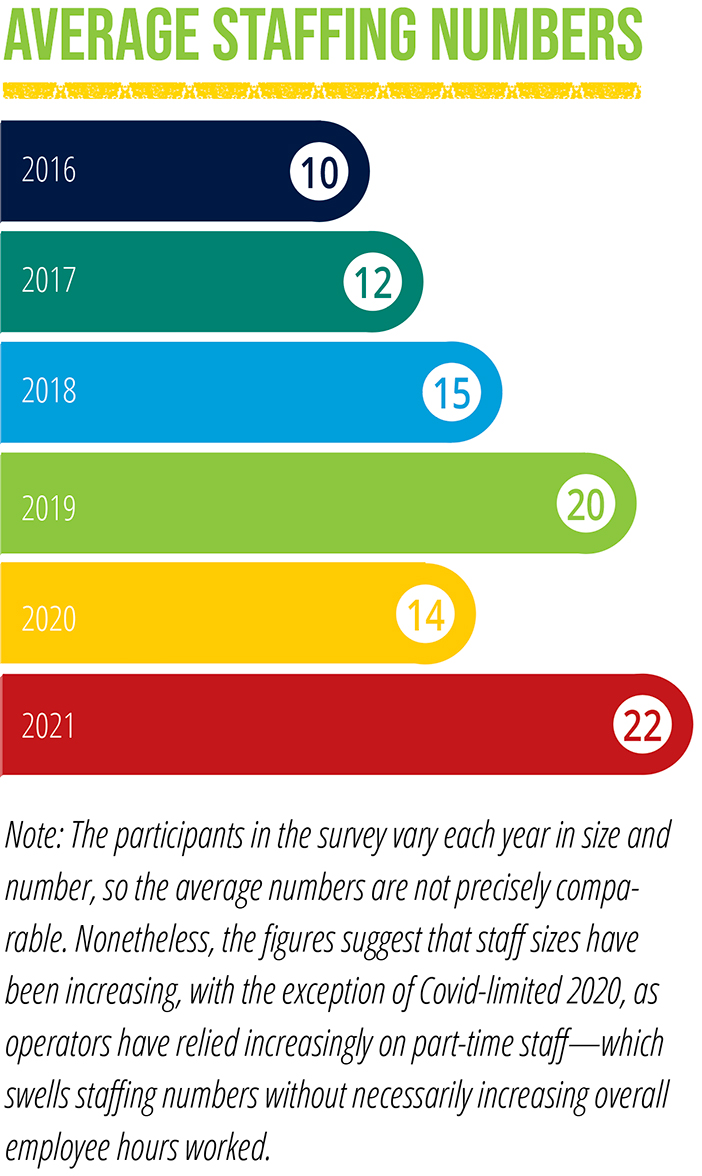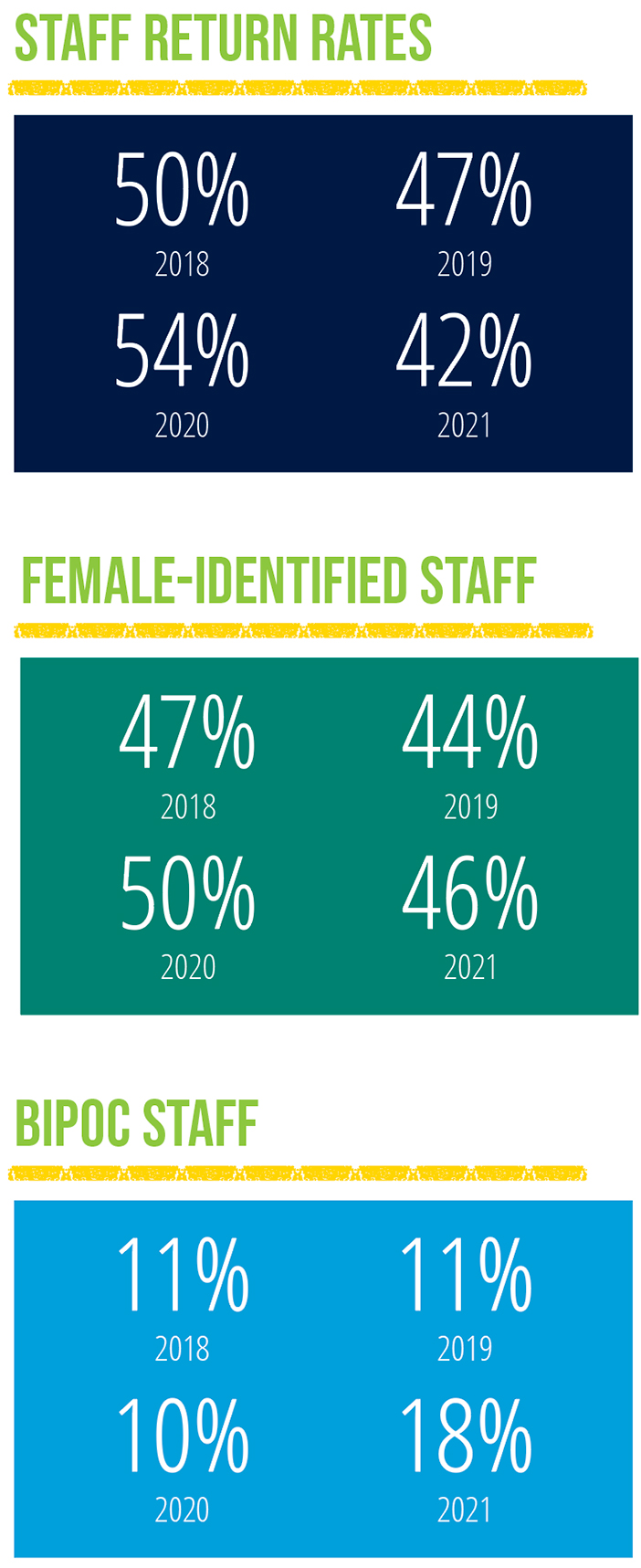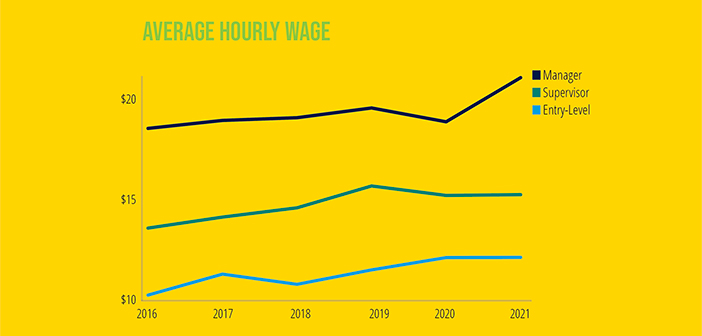Staffing troubles are nothing new in hospitality and tourism, but something about the challenges of 2022 feels different than the challenges of the past. Are they really different, though? While the job market may feel like it’s changing rapidly, the past several years have been no picnic, either. We can learn a lot by looking back, and our annual State of the Industry Report gives us a tool to do so.
Over the past six years, Adventure Park Insider has conducted the annual State of the Industry Survey and collected data on staffing levels, pay rates, demographics, and more for the State of the Industry Report. This historical data can help form a fuller picture of the current situation and where we go from here. History does have a way of repeating itself.
A Perennial Concern
Since at least 2016, finding and managing a qualified staff has been the top concern for operators going into the season every year—with the notable exception of 2021, when staffing dropped to number two behind Covid impacts.
Diving deeper into the anecdotal data, the reasons behind these concerns have come somewhat full circle. In 2016-2017, the rapid growth of the industry, especially for recreational operators, left many scrambling to increase staffing and optimize training in order to meet demand.
In 2018-2019, this concern evolved from a need to increase staffing numbers to a desire to differentiate job offerings and company culture amidst extreme competition for staff. Outdoor recreation, hospitality, and tourism operators were all competing for new hires during a period with the lowest unemployment rates since the late 1960s. This triggered a need to define the unique value proposition each employer could bring to the table for potential employees, and many operators were making great strides going into the 2020 season until…
Covid. As operators were preparing for hiring and training for the 2020 summer season, mandatory shutdowns brought things to a halt. When operators were able to reopen, they did so with skeleton crews, as many people were unwilling to work in close proximity to others. Limited offerings and cross-training allowed operators to reopen, and these strategies carried into 2021.
Covid, year two. While gains were made in terms of efficiency, 2021 saw an immediate and, in some cases, dramatic need to increase staffing numbers to meet the demand for the outdoors. Customers were eager to take part in aerial activities (among many others). This, coupled with the “Great Resignation,” with more than 47 million Americans quitting their jobs, created a unique challenge for outdoor operators. Demand for outdoor activities was as high or higher than pre-pandemic levels, and many employees were reevaluating their relationship with work.
With so many operations hiring, workers have options, and with that come higher expectations. The Associated Press reported that, in March of 2022, employers posted a record 11.5 million job openings. We have returned to the days of 2019, where employers need to think strategically about what differentiates them in order to attract quality hires and meet the growing consumer demand for the outdoors.
Staff Up
Staffing levels were climbing from 2016 through 2019. This is especially true for recreational operators, who were adding a wider array of activities to their operations.
After Covid-related staff cuts in 2020, many operations were able to approach or return to pre-pandemic staffing levels in 2021. Quite a few operators, though, limited the number of new hires going into the season, and focused instead on cross-training and creating career opportunities for high-performing staff members.

What’s your return rate? Return rates are generally a strong indicator of company culture, which has become a focus for operators. During the past four years that Adventure Park Insider has tracked this metric, respondents’ average year-over-year return rates hovered around 48%. That’s at least twice the rate of many other seasonal and hourly industries. According to the Bureau of Labor Statistics, many businesses in these other industries reported return rates of less than 25% year-over-year.
And now? Return rates in aerial adventure operations decreased overall in 2021, down from 54% in 2020 to an average of 42%. This is not surprising, considering that many operators downsized in 2020 and relied primarily on veteran staffers, which boosted the return rate. Then, in 2021, they onboarded a greater percentage of new hires, as many former employees had moved on to new jobs.
It will be crucial for operators to entice current staff to return for 2023, and it’s not too early to begin that effort.

Who’s working the lines?
Historically, outdoor recreation has been a male-dominated industry. The aerial adventure world has been an exception. Between 2017 and 2019, for example, aerial adventure operators reported an average of 44% of staff members as female-identifying.
Editor’s note: The annual State of the Industry Survey has asked for data on male- and female-identified staff only, and has neglected to inquire about non-binary staff—an oversight we will correct in the future.
In 2020, the percentage of female-identifying staff rose, to an average of 50% of staff positions in adventure parks. Traditional operations reported an even higher number, with 61% of their staff positions filled by female-identified employees. In 2021, the male/female ratio returned to its prior level.
Retaining female staff can be a challenge. Federal data show that while many men who left jobs between February 2020 and January 2022 have returned to the workforce, many women have not. Uncertainty over childcare triggered many working women to leave the workforce. In other cases, the increased availability of remote work triggered women to leave frontline roles to gain the flexibility that remote work (or aerial adventure operations) can offer.
Diversity
Another historically underrepresented group in the outdoor industry are BIPOC employees and, for that matter, participants. The adventure park industry has made great strides in this area. In 2018, the first year we tracked this metric, survey respondents indicated that an average of 11% of staff were members of the BIPOC community. In 2021, this metric jumped to an average of 18%.

The challenges of the pandemic forced operators to reach beyond their traditional labor pools, leading to an increase in the diversity of new hires. This is a positive development on many levels. Workplace diversity is proven to be beneficial for staff retention. Research also shows that diverse and inclusive companies outperform those that are not. And diversity has other beneficial societal and humanitarian aspects as well.
Show me the money!
Wages versus inflation. In 2016, the average hourly wage for an entry-level adventure park staffer was $10.22. In 2021, that hourly rate increased to an average of $12.18. That’s an increase of nearly 20 percentage points in a six-year period, and higher than the rate of inflation. For supervisors, wages averaged $13.56 per hour in 2016 and increased to $15.29 in 2021; that is roughly in line with the inflation rate.
However, with inflation rising at 8.6 percent in spring 2022, there’s been pressure to increase pay rates again this year. To determine what employees should be paid, operators should consider not just the hourly rate, but also the local cost of living and the value each employee can bring, monetarily and otherwise.
Revenue per employee. In 2018, the average revenue per staff member was $46,376.85. In 2021, this decreased slightly, down to $40,159.54 per employee. This decrease can be attributed to both the increase in smaller operations responding to the survey, as well as an increased reliance on part-time staff. This reliance on part-timers increases the number of staff but decreases each employee’s opportunity for revenue generation on an individual level. The range for revenue per employee is staggering, with smaller operations relying primarily on part-time staff averaging just over $20,000 per employee, while some larger operations relying more heavily on full-time and year-round staff average up to $116,000 per employee.
So, now what?
The challenges are clear, so what is an operator to do? First is the question of how do you make your operation an attractive place to work.
Employee value propositions. What is your business’s employee value proposition? What is the unique set of benefits that your operation can offer potential hires in exchange for the skills, capabilities, and experience they bring to your workplace?
Fun is a key component of the value proposition, of course, but beyond that, think through company culture, flexibility, transparency, safety, training, and opportunities for growth, both with your company and within the larger industry.
To cast a broad net, especially for entry-level positions, remove barriers such as “prior outdoor experience required.” Instead, focus on the job responsibilities for the role and the traits a prospective employee would need to succeed, such as “detail-oriented” or “interested in interacting with the public.” Skills can be taught.
Flexibility. The pandemic has shown employees the value of flexibility. You can still establish a set schedule—but it must be one that meshes with the employees’ needs. And when employees have life or family obligations that conflict with the schedule, the onus is on the employer to help accommodate any scheduling challenges. This is especially true for women (or anyone) with children who are attempting to re-enter the workforce after struggling with childcare over the past several years. Further, operators can partner with existing childcare programs or, for those who already offer camp programs, offer an employee rate.
Diversity. Adventure park operators have done well here in the past few years and can continue to do so. Encouraging diversity in employees is a long-term effort that will require creativity in how job positions are marketed and the language used for them.
Staffing efficiencies. Many operators learned in 2020 and 2021 that cross-training employees to fill a variety of roles creates staffing efficiencies. When staff gain valuable skills in different aspects of operations, it makes them more valuable to you. And it makes you a more valuable employer for them, as they gain new skills to apply in their careers down the road.
Pay levels. While company culture matters, for seasonal positions in the aerial adventure industry, wages often hold a high position on the priority list. In determining what hourly wage to offer, consider:
- What do your competitors offer?
- What do other companies in your area offer for comparable employment levels?
- On average, how much revenue can you anticipate attributing to each employee?
Selling it. Get creative in marketing your job openings. Courtney Condy, founder of outdoor job board Occupation Wild, says that potential employees, especially entry-level, look at outdoor job descriptions differently. Instead of wordy descriptions, Occupation Wild works with employers to cultivate videos and photos that show the experience of working for the operation. In the era of TikTok and Instagram, a picture really is worth 1,000 words.
The challenges facing operators in the current hiring marketplace are real, but opportunities exist to elevate company culture and employee value propositions to attract and retain new hires. Help them share the excitement and sense of accomplishment that comes from delivering memorable experiences and enriching the lives of your guests. That’s a win for everyone.






